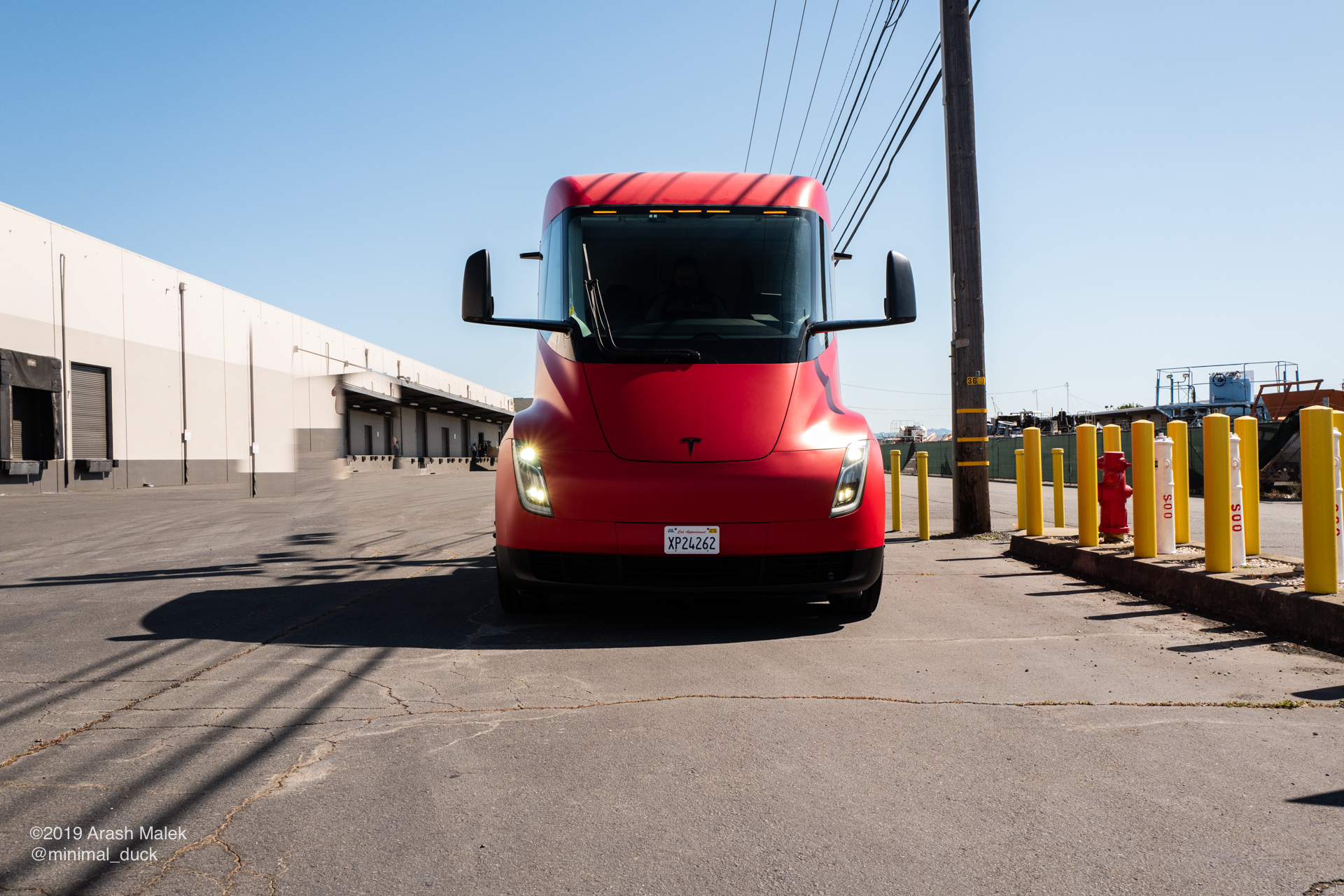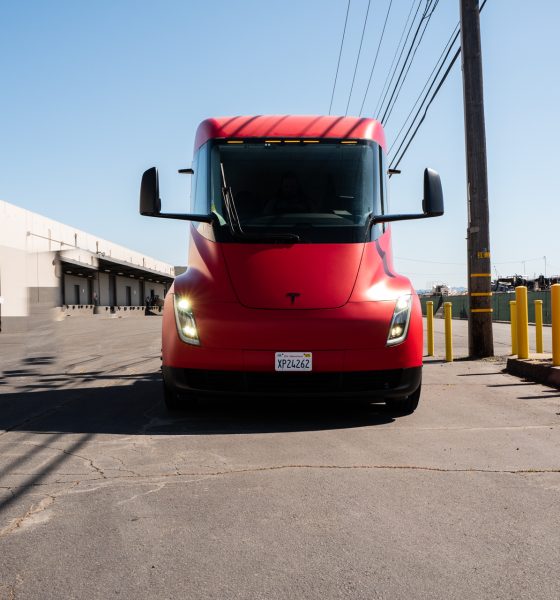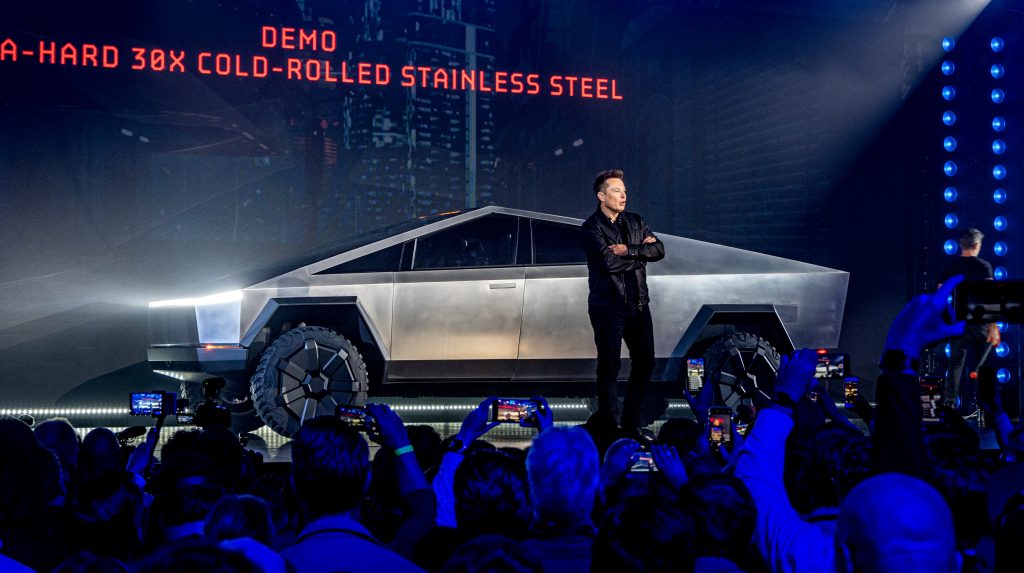

News
Tesla’s battery strategy will be key to Cybertruck and Semi’s market disruption
Elon Musk has remarked that Tesla has arguably the most exciting product roadmap of any company today. With vehicles like the Semi and the Cybertruck coming in the pipeline, this statement rings true. But things will not be as easy as simply setting up production lines for the upcoming vehicles. For Tesla to properly ramp the Semi, for example, the company would have to make sure that it can get enough cells for the vehicle first.
Producing electric cars is no easy task, and a lot of the challenges in EV making are connected in one way or another to vehicles’ batteries. This is something that is being learned by veteran carmakers like Jaguar today, as inadequate supply from battery companies like LG Chem has resulted in a halt of production for premium EVs like the I-PACE. Tesla is certainly aware of the battery supply challenges that EV makers face. This is one of the reasons why Gigafactory Nevada was constructed.
Giga Nevada was built to support the company’s Model 3 ramp. Designed to manufacture the 2170 cells of the Model 3 with battery partner Panasonic, the massive facility forms the backbone of Tesla’s first foray into the mass market. But the story lies far beyond the Model 3 today. Tesla has an even higher-volume vehicle coming, the Model Y. The Cybertruck will likely sell in large volumes too, provided that the market embraces it. Just like the all-electric pickup, the Semi might see sufficient demand from the trucking market once it’s released as well, considering the cost benefits that the vehicle offers.

Tesla is in a constant state of change, and this cannot be represented better than the company’s batteries. President of Automotive Jerome Guillen has noted that Tesla’s batteries are never static since they’re always being improved. Today, it is becoming more and more evident that Tesla’s batteries are among the best in the industry, particularly when it comes to energy density. Coupled with its vertically-integrated software, Tesla’s batteries can give vehicles impressive range even if they are not too large.
The Model 3, for example, can squeeze out over 320 miles of range from a 75 kWh battery, and the Model S Long Range Plus can get 390 miles from a 100 kWh pack. This matters a lot, and it shows just how far ahead the company is when it comes to its batteries and their energy density. And this, ultimately, will likely help the company secure enough battery cells to support the ramp of its upcoming EVs, including the Semi and the Cybertruck, both of which are large vehicles that would usually require a massive pack to hit their target range.
Tesla lists the Semi with a range of 300 to 500 miles. The company never announced the size of the Semi’s battery pack, but considering that the vehicle is a Class 8 truck that can accelerate from 0-60 mph in 20 seconds with a full load, speculations for the vehicle’s battery from the EV community included estimates that were as high as 1 MWh. The same concept applies to the Cybertruck. The vehicle is very heavy, and it is expected to have over 500 miles of range. To get this range, a large battery pack would usually be required.

But with Tesla’s constant innovations on its batteries, this does not necessarily have to be the case. Considering that Tesla is closing in on 400 miles per charge on a 100 kWh pack with the Model S, there is a good chance that its next vehicles like the Cybertruck and Semi will be equipped with fewer, but more energy-dense cells than initially expected. Tesla has pretty much developed the skill of drawing out as much range as possible from every cell in an EV, so it’s not too farfetched to infer that the company will be very efficient with the batteries of its upcoming vehicles.
More energy-dense batteries will be key to lowering production costs as well. Tesla may be drastically reducing its battery costs, but the packs themselves still comprise a huge portion of each of its vehicles’ prices. If Tesla can use slightly smaller packs that are still capable of providing optimum range, Tesla can make sure that its EVs like the Semi and the Cybertruck will be as competitive as possible when they enter the market.
The Tesla Semi and the Cybertruck are competing in the trucking and pickup market, two very lucrative segments in the automotive industry. Interestingly, both segments are also ripe for disruption, with most veterans such as Freightliner and the Ford F-150 sticking to tried and tested strategies to thrive today. Tesla needs a key to ensure that it can have a fighting chance when it enters the trucking and pickup segment with the Semi and Cybertruck. If challenges faced by electric car makers today are any indication, it appears that batteries and their energy density will be the difference-maker. Fortunately, these just happen to be two things that Tesla has been obsessively pursuing since the company was founded less than 17 years ago.

News
Tesla aims to combat common Full Self-Driving problem with new patent
Tesla writes in the patent that its autonomous and semi-autonomous vehicles are heavily reliant on camera systems to navigate and interact with their environment.

Tesla is aiming to combat a common Full Self-Driving problem with a new patent.
One issue with Tesla’s vision-based approach is that sunlight glare can become a troublesome element of everyday travel. Full Self-Driving is certainly an amazing technology, but there are still things Tesla is aiming to figure out with its development.
Unfortunately, it is extremely difficult to get around this issue, and even humans need ways to combat it when they’re driving, as we commonly use sunglasses or sun visors to give us better visibility.
Cameras obviously do not have these ways to fight sunglare, but a new patent Tesla recently had published aims to fight this through a “glare shield.”
Tesla writes in the patent that its autonomous and semi-autonomous vehicles are heavily reliant on camera systems to navigate and interact with their environment.

The ability to see surroundings is crucial for accurate performance, and glare is one element of interference that has yet to be confronted.
Tesla described the patent, which will utilize “a textured surface composed of an array of micro-cones, or cone-shaped formations, which serve to scatter incident light in various directions, thereby reducing glare and improving camera vision.”

The patent was first spotted by Not a Tesla App.
The design of the micro-cones is the first element of the puzzle to fight the excess glare. The patent says they are “optimized in size, angle, and orientation to minimize Total Hemispherical Reflectance (THR) and reflection penalty, enhancing the camera’s ability to accurately interpret visual data.”
Additionally, there is an electromechanical system for dynamic orientation adjustment, which will allow the micro-cones to move based on the angle of external light sources.
This is not the only thing Tesla is mulling to resolve issues with sunlight glare, as it has also worked on two other ways to combat the problem. One thing the company has discussed is a direct photon count.
CEO Elon Musk said during the Q2 Earnings Call:
“We use an approach which is direct photon count. When you see a processed image, so the image that goes from the sort of photon counter — the silicon photon counter — that then goes through a digital signal processor or image signal processor, that’s normally what happens. And then the image that you see looks all washed out, because if you point the camera at the sun, the post-processing of the photon counting washes things out.”
Future Hardware iterations, like Hardware 5 and Hardware 6, could also integrate better solutions for the sunglare issue, such as neutral density filters or heated lenses, aiming to solve glare more effectively.
Elon Musk
Delaware Supreme Court reinstates Elon Musk’s 2018 Tesla CEO pay package
The unanimous decision criticized the prior total rescission as “improper and inequitable,” arguing that it left Musk uncompensated for six years of transformative leadership at Tesla.

The Delaware Supreme Court has overturned a lower court ruling, reinstating Elon Musk’s 2018 compensation package originally valued at $56 billion but now worth approximately $139 billion due to Tesla’s soaring stock price.
The unanimous decision criticized the prior total rescission as “improper and inequitable,” arguing that it left Musk uncompensated for six years of transformative leadership at Tesla. Musk quickly celebrated the outcome on X, stating that he felt “vindicated.” He also shared his gratitude to TSLA shareholders.
Delaware Supreme Court makes a decision
In a 49-page ruling Friday, the Delaware Supreme Court reversed Chancellor Kathaleen McCormick’s 2024 decision that voided the 2018 package over alleged board conflicts and inadequate shareholder disclosures. The high court acknowledged varying views on liability but agreed rescission was excessive, stating it “leaves Musk uncompensated for his time and efforts over a period of six years.”
The 2018 plan granted Musk options on about 304 million shares upon hitting aggressive milestones, all of which were achieved ahead of time. Shareholders overwhelmingly approved it initially in 2018 and ratified it once again in 2024 after the Delaware lower court struck it down. The case against Musk’s 2018 pay package was filed by plaintiff Richard Tornetta, who held just nine shares when the compensation plan was approved.
A hard-fought victory
As noted in a Reuters report, Tesla’s win avoids a potential $26 billion earnings hit from replacing the award at current prices. Tesla, now Texas-incorporated, had hedged with interim plans, including a November 2025 shareholder-approved package potentially worth $878 billion tied to Robotaxi and Optimus goals and other extremely aggressive operational milestones.
The saga surrounding Elon Musk’s 2018 pay package ultimately damaged Delaware’s corporate appeal, prompting a number of high-profile firms, such as Dropbox, Roblox, Trade Desk, and Coinbase, to follow Tesla’s exodus out of the state. What added more fuel to the issue was the fact that Tornetta’s legal team, following the lower court’s 2024 decision, demanded a fee request of more than $5.1 billion worth of TSLA stock, which was equal to an hourly rate of over $200,000.
Delaware Supreme Court Elon Musk 2018 Pay Package by Simon Alvarez
News
Tesla Cybercab tests are going on overdrive with production-ready units
Tesla is ramping its real-world tests of the Cybercab, with multiple sightings of the vehicle being reported across social media this week.

Tesla is ramping its real-world tests of the Cybercab, with multiple sightings of the autonomous two-seater being reported across social media this week. Based on videos of the vehicle that have been shared online, it appears that Cybercab tests are underway across multiple states.
Recent Cybercab sightings
Reports of Cybercab tests have ramped this week, with a vehicle that looked like a production-ready prototype being spotted at Apple’s Visitor Center in California. The vehicle in this sighting was interesting as it was equipped with a steering wheel. The vehicle also featured some changes to the design of its brake lights.
The Cybercab was also filmed testing at the Fremont factory’s test track, which also seemed to involve a vehicle that looked production-ready. This also seemed to be the case for a Cybercab that was spotted in Austin, Texas, which happened to be undergoing real-world tests. Overall, these sightings suggest that Cybercab testing is fully underway, and the vehicle is really moving towards production.
Production design all but finalized?
Recently, a near-production-ready Cybercab was showcased at Tesla’s Santana Row showroom in San Jose. The vehicle was equipped with frameless windows, dual windshield wipers, powered butterfly door struts, an extended front splitter, an updated lightbar, new wheel covers, and a license plate bracket. Interior updates include redesigned dash/door panels, refined seats with center cupholders, updated carpet, and what appeared to be improved legroom.
There seems to be a pretty good chance that the Cybercab’s design has been all but finalized, at least considering Elon Musk’s comments at the 2025 Annual Shareholder Meeting. During the event, Musk confirmed that the vehicle will enter production around April 2026, and its production targets will be quite ambitious.








